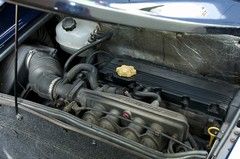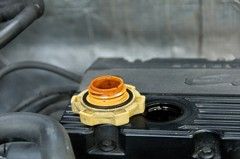Lotus Elise S1 - Powertrain
All road going S1 Elise models use a version of the Rover K Series 1.8-litre engine. The fuel injected 1796cc petrol motor is mid-mounted in the Elise, as it was in the MGF that donated to the Lotus. For the original Elise, it offers 118bhp at 5500rpm and 122lb ft of torque at 3000rpm to make the lightweight Elise surprisingly flexible and tractable. Autocar tested the original Elise and managed 0-60mph in 5.5 seconds.
Every S1 Elise built for the road comes with a five-speed manual gearbox driving the rear wheels. The Sport 135, 111S and Sport 160 models all gained a close ratio gearbox where first and second gears were raised and fifth gear was lowered to make the most of the upper reaches of the engine's rev band. Raising first and second gears had the effect of making the pricier, more powerful models no quicker from 0-60mph than the standard Elise, but on the move these faster cars proved their mettle, with the 111S some 5.8 seconds faster from 0-100mph the 118bhp model.
Search for Lotus Elise S1s here
The Elise's light weight gives the engine and transmission a fairly easy time, even in cars that have been driven hard. Horror stories about the Rover K Series engine's head gasket don't afflict the Elise as badly, though the engine's small coolant capacity means it's best to check the levels carefully and make sure the radiator is air lock-free. The radiator has plastic end caps that will fail, so budget for replacing the radiator if the work has not been completed recently. Also look at the oil filler cap for signs of 'mayonnaise' that are a tell-tale of a blown head gasket. Replacement and uprated gaskets are widely available. Look for leaks from the plastic intake manifold due to heat damage.
Every gear in the five-speed 'box should engage cleanly and precisely. An inaccurate shift is most likely to be worn linkages between lever and gearbox, which are straightforward for a specialist to sort. If this doesn't solve a poor shift action, the synchromesh has probably worn and this means removing the gearbox for a rebuild. The differential is very strong in the Elise, but watch for any whining noises that indicate many hard starts. The Elise is popular as a hill climb car, so this is a more likely problem than in most other sports cars.
Look for evidence of regular oil changes, 12-month or 9000-mile servicing intervals and a new cambelt every 54,000 miles, or 36,000 miles in the Sport 160 model. Only a truly abused engine is likely to fail completely, most likely from worn cylinder liners that will dictate either a full rebuild or new motor. Original exhausts wear through rot, so a stainless steel replacement is common and desirable.
A stiff clutch pedal action is not unheard of in the Elise, so either treat it with regular oil sprays or swap the original bush for a stainless steel pivot.
PH Buying Guide - Lotus Elise S1
Introduction
Powertrain (viewing now)
Rolling Chassis
Body
Interior
Insurance Quotes
Search for Lotus Elise S1s here
Gassing Station | General Gassing | Top of Page | What's New | My Stuff







